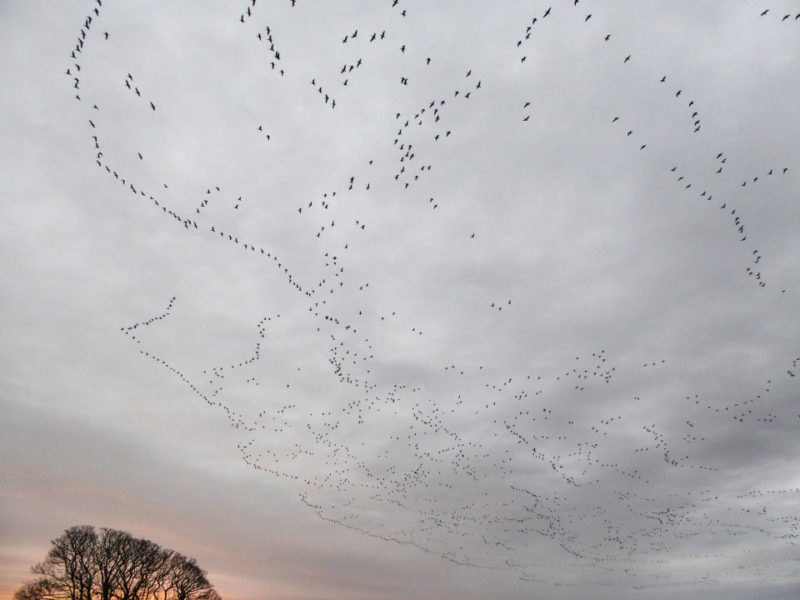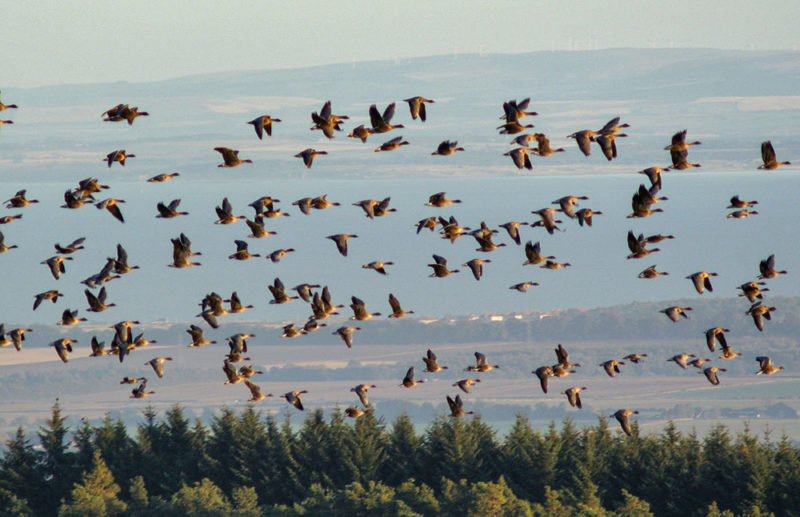
Just five seconds later the strange sound returns. No longer vague and distant, it is now building quickly above both the radio and the birdsong. It surges like a wave and seems to fill the whole house as it pours down the chimney, through the windows and even through the 2ft thick stone walls. I feel a surge of excitement and spill my tea as I rush to the front door, frantically fumbling for the key. This happens almost every day, sometimes twice a day, but its frequency and regularity do nothing to dampen my enthusiasm for it.

The morning exodus over Fife, although this is on the small side!
As I rush out the door my feet feel cold. In my excitement I’ve forgotten to put my shoes on, but what are two soggy socks when one of the most astonishing wildlife spectacles on offer is approaching? And man, is it approaching fast! It seems incredible that something so massive can fly overhead so quickly, but that’s all the more reason to drop everything you’re doing as soon as you hear that noise and seize the moment, for the whole experience can be over almost as soon as it begins.
Passing overhead is the noisiest and perhaps even the largest gathering of animals you’re ever likely to see. Individually they’re rather small compared to other similar species but in these countless thousands they fill the whole sky. Not so much a cloud, rather a shifting web of lines, lattices and V-shapes moving westwards at 30mph and honking as though their lives depended on it. It’s hard to know where to look as each line passes overhead. My eye is drawn to the leading lines as they fade into the distance, but subsequent waves bringing up the rear turn my head and renew the experience a second, and sometimes a third time as the spectacle plays out.
Though the bulk of the web is gone in under 30 seconds and the astonishing noise rapidly diminishes with distance, it continues to reverberate in the solitary calls of the few lonely stragglers that stutter overhead in the following minutes. The last few lines disappear over the hill and then……a loud silence descends. So loud not even the 200 starlings whistling and clicking on the barns next door can penetrate it.
The din lingers in the ears and the mind long after they have gone, and for hours or even days afterwards I still hear the occasional faint honk in my head. Sometimes it’s just the wind whistling around the windows, or the squeaking of the central heating, but more often than not I find I’m just plain imagining it. It’s a noise that somehow gets inside of me and takes up residence for the season, and as autumn wears on and the daily rhythm repeats, a part of my brain is given over to them entirely. Such is life under the flight path of the pink-footed goose.
The pink-footed goose is a fairly small native goose, grey-brown with a short neck and a short dark bill, and with the flushed pink legs that give it its name. When individuals or small groups fly overhead you can easily pick out their distinctive double honk, which is often likened to a high pitched ‘wink wink’. Personally I think they are actually rather softly spoken for a goose, but when you put thousands of soft voices together make no mistake, you have something approaching a cacophony.
No doubt a great many of you are intimately familiar with the ‘pinkies’, if not with their close up features then surely with their V silhouettes and their honking. I was actually blissfully unaware of them until I moved from Edinburgh to Fife, at which point I found myself under their flight path. Small V-shaped flocks of geese are common-place across pretty much the whole country so obviously I’d encountered those before, but somehow I’d managed to spend the bulk of my years beyond the reach of the massive congregations. The simple reason for that is I’d never lived close to any of the handful of areas in the UK that attract such enormous numbers of geese.

The distinctive V of a skein in formation
There are dozens of places in Scotland that regularly host pink-footed geese in large numbers but relatively few of those have populations that run into the thousands. The Montrose Basin in Angus is regularly the single largest roost in Scotland, with an astonishing 42,840 birds counted in October 2016. Other large populations are found at Loch of Skene in Aberdeenshire, the Beauly Firth just outside Inverness, the Solway Firth and West Water in the Pentland Hills.
Just a few miles west of where I stay in Fife is my local goose hotspot, Loch Leven in Kinross-shire, which is the largest body of water in lowland Scotland. Like all the other pink-footed hotspots around the country Loch Leven has two vital components that drive the daily goose spectacle: plenty of open water upon which the geese can safely roost at night, and plentiful food within easy reach – namely grass, agricultural cereals and vegetables.
At dawn, after a night on the water, the geese rise up from the loch in a mass exodus, circling and banding together before radiating out from the centre in large groups, off to spend the day foraging and grazing on the rich agricultural land. At dusk the geese make the homeward commute before settling back down on the water, out of reach of most predators.

The pinkie routine – graze in the fields, roost on the loch
Although the goose commute occurs daily and keeps fairly regular timings, it isn’t a year round spectacle. The bulk of the UK pinkie population spends the summer close to or within the Arctic Circle, where the midnight sun powers a brief but substantial growth in the vegetation on which the geese feed. There, on the tundra of Iceland and the eastern coast of Greenland, the geese use the boom times to breed and moult, nesting on river banks, along streams and gorges or on inaccessible cliff faces. Another population of pink-footed geese spends the summer in Svalbard in Arctic Norway, although most of those spend winter on the North Sea coast of continental Europe rather than the British Isles.
Prompted by deteriorating conditions as the Arctic winter starts to bite, most pink-footed geese leave their summer haunts and arrive in Scotland in late September and October. Numbers steadily build as more geese arrive, reaching a peak in October/November before the geese disperse more widely southwards throughout the rest of the UK.
Although you can say with certainty that pink-footed geese will return to these shores in the autumn, forecasting how many will return is more problematic because the peak numbers of geese found at Scottish sites can vary enormously from year to year. Loch Leven was home to a peak population of just under 10,000 pink-footed geese in 2016, but it had as many as 23,000 in 2013. And while Montrose hosted its peak of nearly 43,000 pinkies in 2016, it has been almost twice that in previous years.
All kinds of factors can determine how many geese turn up in a given location, such as breeding success in the Arctic, an early or a late onset of winter, shooting (both here and in their summer grounds), changes in farmland practices or crop rotation, and of course bad weather and flooding here in Scotland, which can divert geese elsewhere. There is also concern both here and in Iceland about recent hydroelectric projects in the Icelandic highlands, where vast areas of the tundra have been flooded to power aluminium smelters.

Beautiful in flight, this is about as close as I ever manage to get to the geese as they’re very nervous around people.
If you’ve watched the superb and very moving Sigur Ros documentary ‘Heima’ then you will have seen the band join a protest at the Kárahnjúkar dam before it was flooded. The imminent destruction of a pristine Icelandic ecosystem was clear to see, but if you’re anything like me you’ll have watched in complete ignorance as to the danger the dams also posed to our wildlife here in Scotland. The tundra that got flooded was prime breeding habitat for thousands of pairs of pink-footed geese, and there was a real international stink kicked up about it in the early 2000s. Further hydro schemes are planned, and it’s an illustration of the challenges one faces in protecting species that cross international borders, and a reminder of how important it is to coordinate efforts with other countries.
Generally though, pink-footed geese are doing well, thanks in no small part to increased environmental protection and the plentiful agricultural food here during winter. Around 480,000 pink-footed geese were counted in the UK in October 2016, and that represents a whopping 90% of the global population. It’s a success story worth seeing for yourself, and the next few weeks in October and November are the best time to do so. A number of Scottish nature reserves organise dawn goose watches and they’re well worth the effort if can you stomach the early start. Because I promise you, the sight and sound of the dawn exodus is easily on a par with any wildlife spectacle anywhere in the world!
Pink-footed hotspots
Montrose Basin, Angus
Loch of Skene and Loch of Strathbeg, Aberdeenshire
Loch Leven, Kinross-shire
Solway Firth, Dumfries & Galloway
West Water, Pentland Hills
Beauly Firth, Highlands
